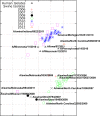Antigenic characterization of H3N2 influenza A viruses from Ohio agricultural fairs
- PMID: 23637412
- PMCID: PMC3700273
- DOI: 10.1128/JVI.00804-13
Antigenic characterization of H3N2 influenza A viruses from Ohio agricultural fairs
Abstract
The demonstrated link between the emergence of H3N2 variant (H3N2v) influenza A viruses (IAVs) and swine exposure at agricultural fairs has raised concerns about the human health risk posed by IAV-infected swine. Understanding the antigenic profiles of IAVs circulating in pigs at agricultural fairs is critical to developing effective prevention and control strategies. Here, 68 H3N2 IAV isolates recovered from pigs at Ohio fairs (2009 to 2011) were antigenically characterized. These isolates were compared with other H3 IAVs recovered from commercial swine, wild birds, and canines, along with human seasonal and variant H3N2 IAVs. Antigenic cartography demonstrated that H3N2 IAV isolates from Ohio fairs could be divided into two antigenic groups: (i) the 2009 fair isolates and (ii) the 2010 and 2011 fair isolates. These same two antigenic clusters have also been observed in commercial swine populations in recent years. Human H3N2v isolates from 2010 and 2011 are antigenically clustered with swine-origin IAVs from the same time period. The isolates recovered from pigs at fairs did not cross-react with ferret antisera produced against the human seasonal H3N2 IAVs circulating during the past decade, raising the question of the degree of immunity that the human population has to swine-origin H3N2 IAVs. Our results demonstrate that H3N2 IAVs infecting pigs at fairs and H3N2v isolates were antigenically similar to the IAVs circulating in commercial swine, demonstrating that exhibition swine can function as a bridge between commercial swine and the human population.
Figures


Similar articles
-
Aerosol Transmission from Infected Swine to Ferrets of an H3N2 Virus Collected from an Agricultural Fair and Associated with Human Variant Infections.J Virol. 2020 Jul 30;94(16):e01009-20. doi: 10.1128/JVI.01009-20. Print 2020 Jul 30. J Virol. 2020. PMID: 32522849 Free PMC article.
-
Introduction, Evolution, and Dissemination of Influenza A Viruses in Exhibition Swine in the United States during 2009 to 2013.J Virol. 2016 Nov 14;90(23):10963-10971. doi: 10.1128/JVI.01457-16. Print 2016 Dec 1. J Virol. 2016. PMID: 27681134 Free PMC article.
-
Novel Reassortant Human-Like H3N2 and H3N1 Influenza A Viruses Detected in Pigs Are Virulent and Antigenically Distinct from Swine Viruses Endemic to the United States.J Virol. 2015 Nov;89(22):11213-22. doi: 10.1128/JVI.01675-15. Epub 2015 Aug 26. J Virol. 2015. PMID: 26311895 Free PMC article.
-
Ecological drivers of evolution of swine influenza in the United States: a review.Emerg Microbes Infect. 2025 Dec;14(1):2455598. doi: 10.1080/22221751.2025.2455598. Epub 2025 Jan 28. Emerg Microbes Infect. 2025. PMID: 39817666 Free PMC article. Review.
-
Genetic and antigenic evolution of swine influenza viruses in Europe and evaluation of their zoonotic potential.Zoonoses Public Health. 2009 Aug;56(6-7):310-25. doi: 10.1111/j.1863-2378.2009.01236.x. Zoonoses Public Health. 2009. PMID: 19497089 Review.
Cited by
-
Detection of Antigenic Variants of Subtype H3 Swine Influenza A Viruses from Clinical Samples.J Clin Microbiol. 2017 Apr;55(4):1037-1045. doi: 10.1128/JCM.02049-16. Epub 2017 Jan 11. J Clin Microbiol. 2017. PMID: 28077698 Free PMC article.
-
Comparison of Adjuvanted-Whole Inactivated Virus and Live-Attenuated Virus Vaccines against Challenge with Contemporary, Antigenically Distinct H3N2 Influenza A Viruses.J Virol. 2018 Oct 29;92(22):e01323-18. doi: 10.1128/JVI.01323-18. Print 2018 Nov 15. J Virol. 2018. PMID: 30185589 Free PMC article.
-
A sequence-based machine learning model for predicting antigenic distance for H3N2 influenza virus.Front Microbiol. 2024 Jan 19;15:1345794. doi: 10.3389/fmicb.2024.1345794. eCollection 2024. Front Microbiol. 2024. PMID: 38314434 Free PMC article.
-
Influenza A subtype H3 viruses in feral swine, United States, 2011-2012.Emerg Infect Dis. 2014 May;20(5):843-6. doi: 10.3201/eid2005.131578. Emerg Infect Dis. 2014. PMID: 24751326 Free PMC article.
-
Feral Swine in the United States Have Been Exposed to both Avian and Swine Influenza A Viruses.Appl Environ Microbiol. 2017 Sep 15;83(19):e01346-17. doi: 10.1128/AEM.01346-17. Print 2017 Oct 1. Appl Environ Microbiol. 2017. PMID: 28733290 Free PMC article.
References
-
- Wells DL, Hopfensperger DJ, Arden NH, Harmon MW, Davis JP, Tipple MA, Schonberger LB. 1991. Swine influenza virus infections. Transmission from ill pigs to humans at a Wisconsin agricultural fair and subsequent probable person-to-person transmission. JAMA 265:478–481 - PubMed
-
- Killian ML, Swenson SL, Vincent AL, Landgraf JG, Shu B, Lindstrom S, Xu X, Klimov A, Zhang Y, Bowman AS. 2013. Simultaneous infection of pigs and people with triple-reassortant swine influenza virus H1N1 at a U.S. county fair. Zoonoses Public Health 60:196–201 - PubMed
Publication types
MeSH terms
Substances
Grants and funding
LinkOut - more resources
Full Text Sources
Other Literature Sources
Medical
Miscellaneous

